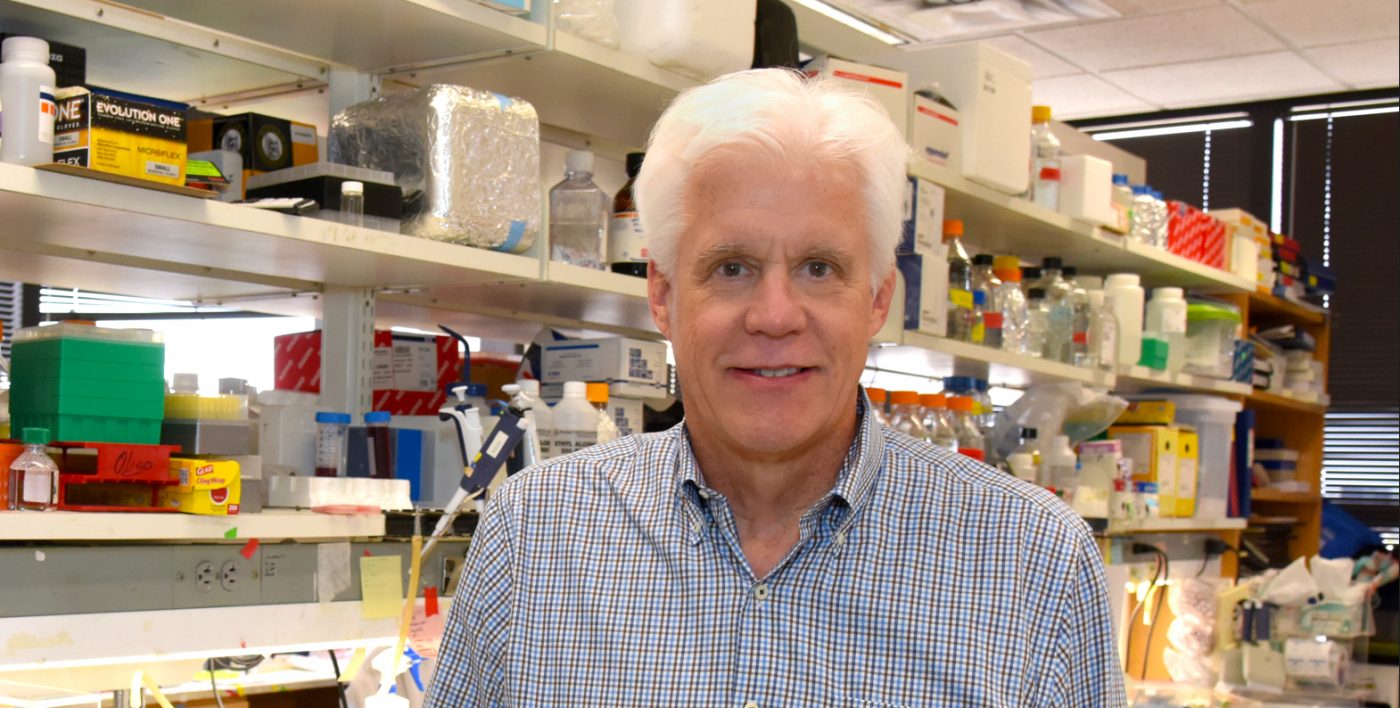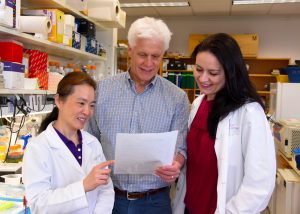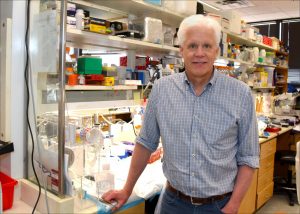UT Researcher, with Cure Duchenne Support, Launches Company to Treat DMD Using CRISPR/Cas9 Technology

Eric Olson, director of UT Southwestern’s Hamon Center for Regenerative Science and Medicine, is the founder of Exonics Therapeutics. (Photo courtesy of UT Southwestern)
Eric Olson, a molecular biologist, has spent more than half his life in the lab. Now, the 62-year-old University of Texas researcher and distinguished professor is a businessman as well.
Olson, director of UT Southwestern’s Hamon Center for Regenerative Science and Medicine in Dallas, has teamed up with the nonprofit group CureDuchenne — through its investment arm — to form Exonics Therapeutics.
The new company, based in Cambridge, Massachusetts, will use the CRISPR/Cas9 gene-editing technique known as SingleCut with the aim of correcting up to 80 percent of the 3,000 mutations that cause Duchenne muscular dystrophy (DMD).
CureDuchenne Ventures joined with Olson to co-found Exonics in February 2017, committing up to $5 million in seed money. The Column Group, a San Francisco venture capital firm, joined in November, pouring $40 million into the new company. John Ripple is CEO of Exonics, and Olson is its founder and chief science advisor.
“I’ve dedicated my career to studying the biology of muscle — how it forms, how it functions,” Olson told Muscular Dystrophy News Today in a phone interview from Dallas. “And over the years, my trainees have discovered many of the key genes that regulate those processes of muscle. When we started reading about CRISPR and the ability to edit genes so precisely, we wondered whether we could apply that technology to diseases that we knew a lot about. There are hundreds of monogenetic disorders of muscle caused by single mutations.”
Olson explained that the mutations which cause Duchenne — a devastating muscle disease that affects 15,000 boys in the United States and around 300,000 worldwide — are clustered into hotspots, or regions, on the massive dystrophin gene that are particularly susceptible to errors.
“We ultimately realized we could correct a very large percentage of these mutations with a simple strategy, which we refer to as SingleCut CRISPR, where we use a single short-guide RNA to deliver [the] cas9 enzyme to a hotspot region of the gene,” he said.
“We make a small insertion or deletion — a so-called ‘indel’ — at that region. This can allow skipping of a mutant exon and restoration of dystrophin expression.”
Dystrophin like a ‘shock absorber’
In recent proof-of-concept studies, Olson said his team tested SingleCut CRISPR in mice, and in human cells obtained from boys with Duchenne.
“We then created mice that harbor the most common mutation in people and we were able to correct those mutations and restore dystrophin expression in mouse models,” he added, explaining that his approach uses a single cut at defined points in the dystrophin gene. That would eliminate the need for a gene-editing tool for each DMD mutation.
“This can’t be applied to every disease, but Duchenne is especially amenable to this type of strategy, because with only a single cut in the genomic DNA, we can restore production of the protein through exon skipping,” he said.
“Dystrophin protein is like a shock absorber with multiple coils in the central region. You don’t need every coil to work for it to function. We can use CRISPR to skip mutations in the coiled domain of the protein.”
The restored protein “is not perfect; it’s analogous to putting a spare tire on a car,” Olson added, but “it gets you where you want to go.”
Findings were reported in two studies led by Olson: “Single-cut genome editing restores dystrophin expression in a new mouse model of muscular dystrophy,” published in late 2017 in Science Translational Medicine, and “Correction of diverse muscular dystrophy mutations in human engineered heart muscle by single-site genome editing,” published in January in Science Advances.
Setting up a company was a logical next step, the researcher said, because “you can’t develop a therapeutic in an academic laboratory. It requires a corporate biotech environment to advance the technology” beyond the academic “blueprint” that early lab suggests.
Dystrophy groups step up
Parent Project Muscular Dystrophy (PPMD) awarded Olson a $250,000 grant in January 2017 to support his ongoing work into CRISPR/Cas9 as a possible treatment for Duchenne.
Pat Furlong, president and CEO of the New Jersey-based nonprofit group, called CRISPR “a potential breakthrough.”
“PPMD is pleased that Dr. Olson was an early pioneer of the technology,” Furlong said in an emailed statement. “We are proud to have been an early supporter of his efforts to further develop it into a safe and effective therapy.”
A few months later, Olson received a $5 million funding commitment from CureDuchenne Ventures, enabling both parties to launch Exonics.
Debra Miller, president and CEO of Cure Duchenne, noted that SingleCut CRISPR technology is “still early science,” and that “a lot needs to be learned before we enter into human clinical trials.”
Even so, this represents “the first potential treatment” to correct the actual defect in the dystrophin gene that causes Duchenne, she said in a phone interview from the group’s headquarters in Newport Beach, California.
“Dr. Olson’s work is extremely important. We’ve made great progress moving drugs into clinical development,” Miller added, noting the U.S. Food and Drug Administration’s approval of Sarepta’s Exondys 51 (eteplirsen) — an exon-skipping infusion therapy — in September 2016. “Up until now, drugs have either treated a small patient population within Duchenne or have just slowed the disease. Dr. Olson’s CRISPR/Cas9 research shows the potential to provide significant dystrophin in the muscle cells that could change the course of this disease.”
Miller’s organization has 13,000 Facebook followers and an annual budget of around $5 million.
“CureDuchenne has a venture philosophy model. Our deep scientific knowledge allows us to discover and vet the best research to move forward,” she said. “We tend to work with early-stage biotech companies and offer funding, which provides proof-of-concept.
“After that, either larger biotech or pharmaceutical companies, or venture capital firms, come in with a much larger investment and move the drug development process along.”
‘Years, not decades’ before CRISPR in trials?
Miller estimated that decisions to support Olson and help establish Exonics involved at least a year of preparation.
“We investigated CRISPR/Cas9 and spoke with a lot of different scientists and companies, and we concluded that he was the furthest along,” she said. “His system, which is a single-guide RNA, along with his scientific expertise, we believe showed the most promise for Duchenne.”
Olson discounted the likelihood his treatment could cause unwanted “off-target” side effects, a concern with gene therapies in general.
“We think that in vivo, off-target effects are minimal or virtually non-existent. Muscle may be particularly resistant because muscle cells don’t divide,” Olson told us.
“We are really encouraged about the data suggesting this can be a life-changing therapy for patients who need it,” though more work is needed “to ensure safety and establish the long-term durability of this approach.”
Assuming that work succeeds, Olson said, “we’re talking a few years before we can move this into initial human trials. We’re not talking decades. We just have to proceed in a very careful, systematic way” — meaning researchers must analyze exactly what’s happening in vivo, or within a living being or organism, when delivering CRISPR.
“We need to make sure it’s safe, to assess immune response, and to ensure whether this gene editing strategy is long-lived,” he said. “We believe it will be, particularly in the heart. We’re still trying to optimize the delivery strategy to make this as efficient as possible. At the moment, we’re using AAV [adeno-associated virus], which is harmless, as a delivery vehicle. So far, it’s been highly efficient.”
Olson largely shrugged off, for now, a question as to whether a process like SingleCut CRISPR — unlike new medicines or medical devices — can even be patented or protected under the law.
“There’s a lot of debate about who owns the CRISPR patent. I don’t think anyone knows, but we’re just pressing on as aggressively as we can,” he said. “At some point the intellectual property issues will sort themselves out, but at the moment it doesn’t make sense for us to stand idle.”
Olson added: “I am really optimistic about this new approach, and I’m determined to give it my all to make it work.”








